Monday, August 7th 2017

Intel Unveils Full Intel Core X-series Processor Family Specs; 14- to 18-Core
Today, Intel is releasing the specifications for the 12- to 18-core processors: Intel Core i9-7920X, Intel Core i9-7940X, Intel Core i9-7960X and the Extreme Edition Intel Core i9-7980XE processors. Announced at Computex 2017, the Intel Core X-series processor family is the most powerful, scalable and accessible high-end desktop platform offered by Intel, designed to deliver the performance needed to meet extreme computing demands for virtual reality (VR), content creation, gaming and overclocking.
The new X-series processor family is the ultimate platform for content creators and gamers. Multitasking becomes extreme mega-tasking with simultaneous, compute-intensive, multithreaded workloads aligned in purpose, powered by up to 18 cores and 36 threads. And, with up to 68 PCIe 3.0 lanes on the platform, people have the ability to expand their systems with fast SSDs, up to four discrete GFX cards and ultrafast Thunderbolt 3 solutions.Content creators can expect up to 20 percent better performance for VR content creation and up to 30 percent faster 4K video editing over the previous generation. This means less time waiting and more time designing new worlds and experiences. Gamers and enthusiasts will experience up to 30 percent faster extreme mega-tasking for gaming over the previous generation.
The 12-core Intel Core X-series processor will be available starting on Aug. 28, and 14- to 18-core Intel Core X-series processors will be available starting Sept. 25. The 4- to 10-core Intel Core X-series processors are already on shelves and available at multiple retailers, along with more than 200 Intel X299 Chipset motherboards.
The new X-series processor family is the ultimate platform for content creators and gamers. Multitasking becomes extreme mega-tasking with simultaneous, compute-intensive, multithreaded workloads aligned in purpose, powered by up to 18 cores and 36 threads. And, with up to 68 PCIe 3.0 lanes on the platform, people have the ability to expand their systems with fast SSDs, up to four discrete GFX cards and ultrafast Thunderbolt 3 solutions.Content creators can expect up to 20 percent better performance for VR content creation and up to 30 percent faster 4K video editing over the previous generation. This means less time waiting and more time designing new worlds and experiences. Gamers and enthusiasts will experience up to 30 percent faster extreme mega-tasking for gaming over the previous generation.
The 12-core Intel Core X-series processor will be available starting on Aug. 28, and 14- to 18-core Intel Core X-series processors will be available starting Sept. 25. The 4- to 10-core Intel Core X-series processors are already on shelves and available at multiple retailers, along with more than 200 Intel X299 Chipset motherboards.




35 Comments on Intel Unveils Full Intel Core X-series Processor Family Specs; 14- to 18-Core
But intel is Very much so a force to be reckoned with at 6-10 core that they must play on till Zen2 comes with improved clocking.
Reports show that XFR on B2 may see 4.4 ghz or more likely 4.3 and 4 ghz allcore which means AMD is plugging the gap rapidly and then Intel can only compete on price to performance like AMD have had to for years.
I hope Intel really suffers for a good portion of 2017, it means they will wake up and make even better products and that AMD can keep up their pace after Zen2.
Looks like a heated market till 2020!
Don't get me wrong, that many threads is nice. At the same time using TIM instead of soldering for 18 core HEDT is simply insane. Plus that freaking price! If i am buying a new platform i would 100% go AMD Threadripper.
I ask because that's my next upgrade if it's on AM4.
Nice try Intel; Your days of the Extreme king are over! It's been 5 years since I upgraded because your CPUs have stagnated yet your prices increased for a mere 10% performance gain? Then you expect me to buy a whole new mobo that are just as crazy priced? Then there is the fact that 3rd party manufacturers are scratching their heads over your decision to race out products to play catch up... time to get a new CEO and rethink your marketing strategy!
Well, when you put it that way.....
But seriously, I upgraded cheaply and frequently in the past and hit a wall in 2012, right when AMD started tanking badly leaving me, and others, with no real options for any significant gains. I applaud AMD for getting their house in order and is finally offering innovation and competition!
What people also need to remember is that those 24 lanes are rarely all ever available to be used as PCI-e lanes. Many of them serve multiple roles and there are a lot of cases where you might lose PCI-e 1x slots or SATA ports when you use an M.2 card because the lanes are sometimes shared kind of like how when you use one of the 8x PCI-e slots in your motherboard, it makes another 16x drop down to 8x, because they're splitting the lanes. So people have to remember that those 24 lanes includes M.2 slots or SATA(and express) ports or extra ICs that a motherboard manufacturer adds to the motherboard to add more functionality or just as PCI-e lanes. Simply put, it's still a PCH. You know what PCH stands for right? Probably Can't Help.
Edit: I'm being harsh but, when I say this, I mean for any truly intensive purpose. The PCH is great for peripherals or networking but not for when you need a lot of bandwidth.